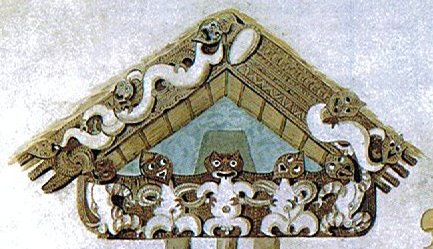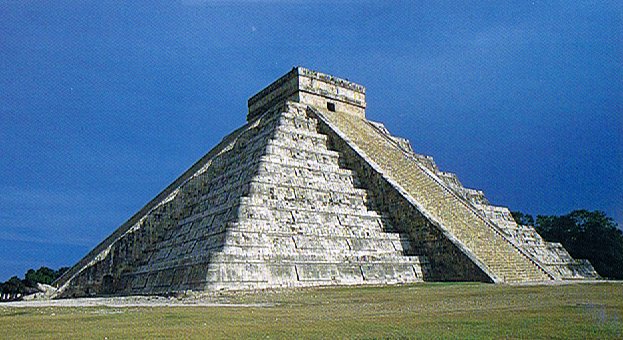4. The point of the spear Pierce-the-sky should be, I think, at the apex of the sky roof, at midsummer. The egg produced from the head of the king suggests sky - which only the feathered birds can reach - yet the undulating bodies say 'serpent', and together we can read 'feathered serpent' (Quetzalcoatl):
In another tongue it becomes Kukulkan:
"Behind me, towering almost 100 feet into the air, was a perfect ziggurat, the Temple of Kukulkan. Its four stairways had 91 steps each. Taken together with the top platform, which counted as a further step, the total was 365. This gave the number of complete days in a solar year. In addition, the geometric design and orientation of the ancient structure had been calibrated with Swiss-watch precision to achieve an objective as dramatic as it was esoteric: on the spring and autumn equinoxes, regular as clockwork, triangular patterns of light and shadow combined to create the illusion of a giant serpent undulating on the northern staircase." (Graham Hancock, Fingerprints of the Gods.) The terrified king has reason to be afraid. The 'head of the tree' will be lopped off: ... Midsummer is the flowering season of the oak, which is the tree of endurance and triumph, and like the ash is said to 'court the lightning flash'. Its roots are believed to extend as deep underground as its branches rise in the air - Virgil mentions this - which makes it emblematic of a god whose law runs both in Heaven and in the Underworld ... The month, which takes its name from Juppiter the oak-god, begins on June 10th and ends of July 7th. Midway comes St. John's Day, June 24th, the day on which the oak-king was sacrificially burned alive. The Celtic year was divided into two halves with the second half beginning in July, apparently after a seven-day wake, or funeral feast, in the oak-king's honour ... But the question still remains whether we can be certain that this time of the year also corresponds to the change from the front side to the back side of the G text:
The bottom part of Gb1-6 is a sign of nuku, a glyph type like tagata but without his 'bird wings'. However, the top part of Gb1-6 is a sign which alludes to the 'bird wings', it is a viri turned on its face:
The feather signs at the back side of the overturned bird wings indicate 'fire', maybe simiilar to the day when the oak-god was burned alive. 9 + 9 = 18 could refer to 18 times 10 = 180 days:
The top - lopped off - part of nuku in Gb1-6 seems to have been turned upside down and kept for the next part of cycle: ... His tanist, or other self, appearing in Greek legend as Poeas who lighted Hercules' pyre and inherited his arrows, succeeds him for the second half of the year; having acquired royal virtue by marriage with the queen, the representative of the White Goddess, and by eating some royal part of the dead man's body - heart, shoulder or thigh-flesh ... The top of this overturned head is pointed like a spear head. 1-6 could allude to 16 (Jupiter) and 1-7 to 17 (Venus), yet 7 means Mars, and the result is a combination of Mars and Venus - she moves on into the dark season carrying the overturned head of Mars. |







